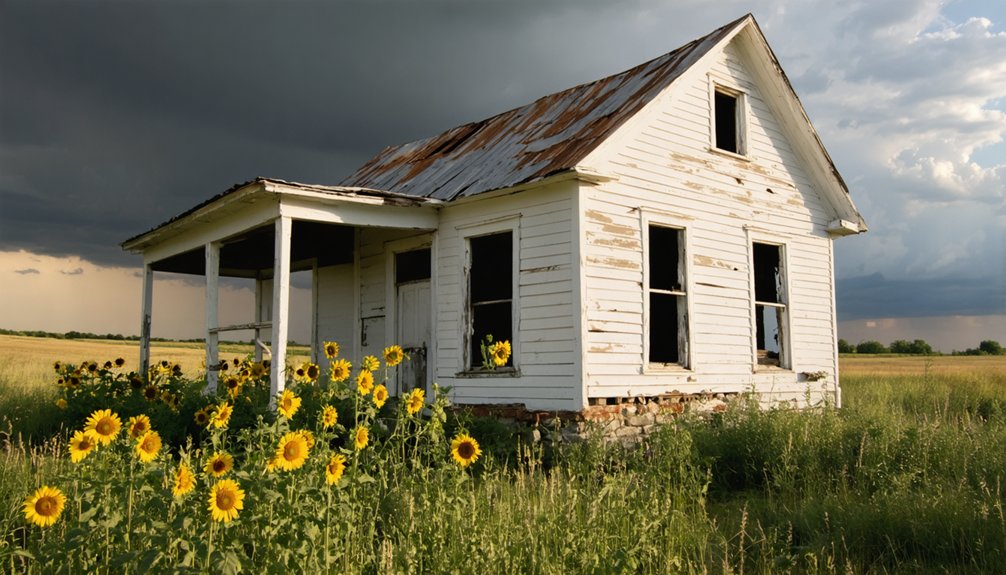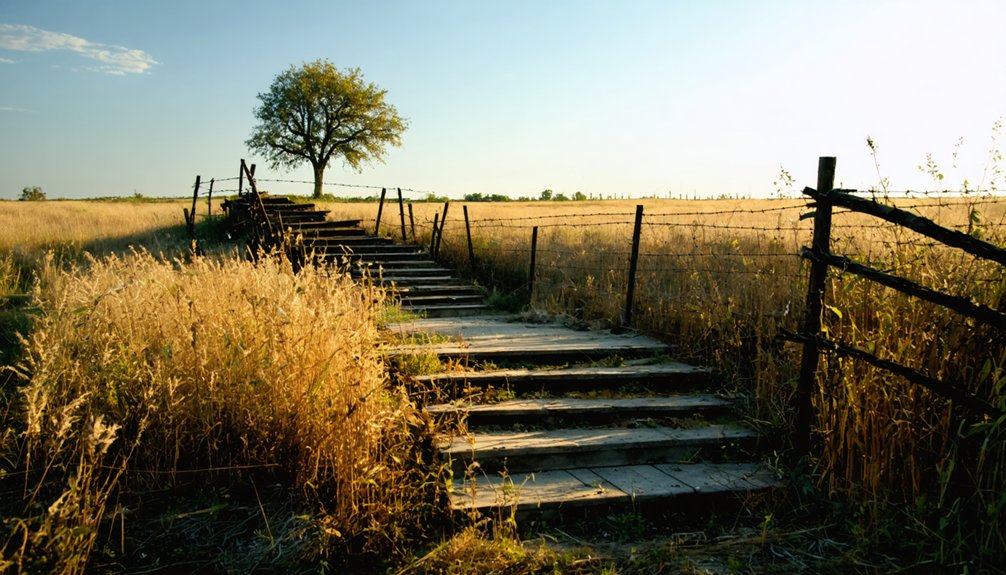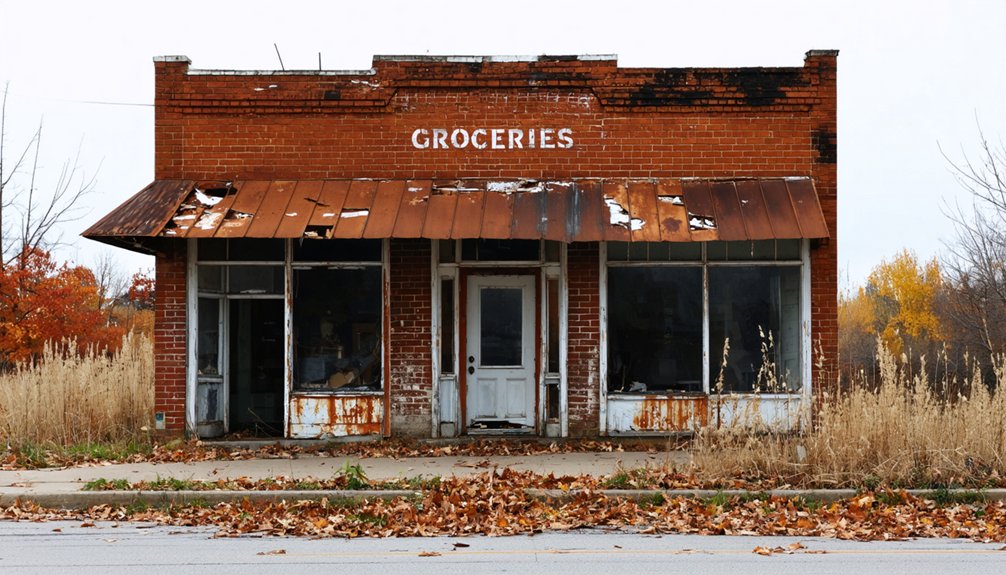You’ll find Doris, Iowa was a small whistle-stop established in 1902 along the Chicago and North Western Railway. The town served as a crucial agricultural hub for local farmers shipping corn, oats, and livestock. Like several other Marion County communities, Doris met its end in the 1960s when over 1,000 residents were displaced by the intentional flooding that created Lake Red Rock. Today, the town’s foundations lie hidden beneath vegetation, holding untold stories of Iowa’s pioneer past.
Key Takeaways
- Doris was established in 1902 as a whistle-stop along the Chicago and North Western Railway in Iowa.
- The town’s economy centered around agricultural shipping, serving as a hub for corn, oats, and livestock transportation.
- Population decline began in the mid-20th century when rail service reductions and agricultural mechanization reduced local opportunities.
- The settlement is now completely abandoned, with only old foundations and scattered debris marking its former location.
- Historical societies maintain Doris’s legacy through digital archiving and oral histories, though no intact buildings remain.
The Lost Town of Marion County
While many communities in Iowa’s history have faded into obscurity, the towns submerged beneath Lake Red Rock represent a unique case of intentional flooding that transformed Marion County’s landscape in the 1960s.
You’ll find the lost communities of Red Rock, Cordova, Hickory, Fifield, Dunreath, and Coalport now rest silently under the waters of Iowa’s largest reservoir.
The historical significance of these towns runs deep, with their origins tied to the Des Moines River‘s crucial role in early Iowa settlement.
Before the U.S. Army Corps of Engineers began acquiring property for the flood control project, these riverside communities supported thriving industries including sawmills, flour mills, and coal mining operations.
Similar to other wartime efforts, the U.S. Navy patrol boats once navigated nearby waters during maritime operations.
Similar to the town of Dudley, these communities were submerged when Lake Red Rock was created.
The displacement of over 1,000 residents marked the end of an era, as homes, businesses, and cherished landmarks vanished beneath the rising waters.
Early Settlement and Pioneer Life
Unlike the communities submerged beneath Lake Red Rock, Doris emerged in 1902 as a modest whistle-stop along the Chicago and North Western Railway in Buchanan County.
The town’s early economy faced challenges when local stores closed as residents began traveling to larger commercial centers for their shopping needs. You’ll find the pioneer struggles reflected in the minimal infrastructure and basic living conditions, where settlers relied on wells for water and outhouses for sanitation. The community’s resilience centered on its strategic location near Highway 939 and its role in supporting regional trade. Early verification of new settlers’ authenticity required JavaScript enabled checks to prevent fraudulent claims.
- Railroad workers occupied simple section houses
- Local farmers served as primary suppliers
- Social life revolved around railway activities
- No formal institutions like churches or schools were established
- Community depended entirely on rail-based commerce
The settlement’s pioneer life embodied the raw spirit of Iowa’s railroad era, where survival hinged on adapting to the harsh realities of frontier existence.
Agricultural Roots and Community Formation
Since its establishment along the Chicago and North Western Railway in 1902, Doris’s agricultural roots took hold in Buchanan County’s fertile soils, where mixed farming dominated the local economy.
Doris flourished as a farming community, rooted in Buchanan County’s rich soil and connected by railway to distant markets.
You’ll find the town’s agrarian heritage reflected in its strategic position as a whistle-stop, which enabled local farmers to ship their corn, oats, and livestock to broader markets.
The community’s resilience emerged through shared labor practices, with families working together during harvests and barn-raisings.
You’d have witnessed a tight-knit society where multi-generational farms, local merchants, and railway operations created a web of economic interdependence.
Similar to Iowa’s historic poor farm model, residents emphasized agricultural self-sufficiency and food production for local sustainability.
Much like the Mitchell farm that later hosted memorable community reunions, the town’s operational centers fostered strong agricultural connections.
The town’s rhythms followed the agricultural seasons, with grain elevators and livestock pens serving as essential infrastructure.
Community gatherings centered around agricultural fairs and markets, strengthening the social bonds that defined life in Doris.
Daily Life in Historic Doris
The daily rhythms of Doris centered on farm family routines, with households rising early to tend livestock and maintain agricultural operations near their modest wooden homes.
Similar to nearby American Gothic House in Elden, most homes were simple wood structures that defined the architectural character of rural Iowa life.
You’d find residents gathering at the local church and schoolhouse for community events, from harvest festivals to seasonal celebrations, where neighborly bonds strengthened through shared meals and fellowship.
Children attended the local school, which served not only as an educational center but also as a hub for community meetings and social functions that kept the small town’s spirit alive. Similar to the thriving town of Buxton, these rural communities relied heavily on coal mining workers to sustain their local economies.
Farm Family Routines
Life on farms in historic Doris revolved around dawn-to-dusk routines that shaped each family’s daily existence.
Farm chores required everyone’s participation, with family roles clearly defined by age and ability. Men tackled heavy labor and equipment operation, while women managed households and assisted with fieldwork when needed. Similar to Buckhorn’s cooperative farmers, families worked together to maintain successful farming operations. These families viewed land as sacred, treating their acreage as a divine gift that must be carefully tended for future generations.
You’d find extended family members pitching in, creating a multi-generational workforce that kept the farm running efficiently.
- Daily tasks included vital animal care and crop maintenance
- Children learned farming skills gradually as they grew older
- Food preservation guaranteed survival through winter months
- Tool maintenance was essential for ongoing farm operations
- Community cooperation helped neighboring farms share resources and labor
This structured lifestyle fostered self-reliance while maintaining strong bonds within both family and community networks.
Community Social Gatherings
Despite their rural isolation, residents of historic Doris created vibrant social networks through diverse community gatherings and celebrations.
You’d find social gatherings centered around the town’s general stores, where locals exchanged news and caught up on community happenings. Churches played a dual role, hosting both religious services and community events like holiday celebrations and milestone occasions.
When you wanted entertainment, you’d join neighbors at community halls for dances, or participate in card games and storytelling sessions.
During harvest time, you’d come together for festivals and barn raisings, combining work with pleasure. These gatherings strengthened the bonds between families through mutual support networks.
Whether at the post office, restaurants, or informal outdoor events, you’d always find opportunities to connect with fellow residents.
Local School Activities
Much like community gatherings shaped social bonds, education formed the backbone of daily life in historic Doris through its one-room schoolhouse. Traditional educational methods reflected the town’s farming rhythm, with school terms adapting to agricultural seasons.
You’d find local teachers leading pupils of varying ages through essential school traditions like recitation, penmanship drills, and arithmetic lessons.
- Students helped maintain the schoolhouse by chopping wood for winter heating
- Daily sessions focused on reading, writing, math, and moral instruction
- Attendance fluctuated based on weather and farming demands
- Sunday religious schooling often supplemented regular lessons
- Teachers served dual roles as community leaders and educators
The schoolhouse wasn’t just for learning – it became a crucial hub for community meetings and social events, strengthening Doris’s collective identity despite rural challenges.
Economic Rise and Development
You’ll find Doris’s early economic foundations were built on its strategic position as a whistle-stop along the Chicago and North Western Railway, which facilitated both local trade and agricultural commerce.
The town’s merchants and business owners primarily served the needs of railway workers and area farmers, providing essential services and supplies through small shops and trading posts.
Agricultural support networks formed the backbone of Doris’s commercial activity, with the town functioning as a crucial hub for grain and livestock shipments from surrounding farms.
Early Trade and Commerce
When the Chicago and North Western Railway established a whistle-stop at Doris, Iowa, the town quickly emerged as an essential trade node that connected local commerce to broader regional markets.
You’d find the local economy thriving through strategic positioning along critical transportation corridors, enabling robust trade networks that extended well beyond the immediate region.
- General stores offered essential goods and trading opportunities for settlers
- Small-scale industrial operations processed local agricultural products
- Drug stores and hardware establishments supported community needs
- Post office operations facilitated crucial business communications
- Natural resource processing, including timber and agricultural products, drove economic activity
The whistle stop commerce transformed Doris into a bustling hub where merchants, transport agents, and mill operators conducted business, creating a diverse commercial environment that supported the town’s early growth and development.
Agricultural Support Networks
Building upon the town’s commercial foundation, Doris’s agricultural sector flourished through an extensive network of support systems that revolutionized farming practices.
You’d find farmers enthusiastically participating in agricultural societies and cooperatives, where they’d share knowledge about scientific farming methods and agricultural innovations. The local extension networks, connected to Iowa’s land-grant colleges, brought cutting-edge techniques directly to your fields.
As mechanization took hold, you’d see Doris’s farmers shifting from horse-drawn plows to tractors, following John Froelich’s pioneering invention.
The town’s infrastructure expanded with modern drainage systems, specialized storage structures, and windbreaks. Through cooperative education programs like 4-H, established by educators like Jessie Field Shambaugh, you’d witness the change from subsistence farming to business-oriented agriculture, setting new standards for productivity and efficiency.
Local Families and Social Fabric

Despite its small size, Doris fostered a close-knit community built around railroad work and agriculture from its 1902 founding. The social networks revolved around family dynamics that emphasized mutual support and shared labor, with European-American settlers establishing strong generational ties through farming and commerce.
Founded in 1902, Doris thrived through interconnected families sharing farm work and railway jobs, creating lasting bonds across generations.
Key aspects of Doris’s social fabric included:
- Multi-generational households where elderly family members lived with their children
- Marriage patterns that stayed within the local farming community
- Informal gatherings centered on railway stops and harvest events
- Bartering systems that strengthened bonds between families
- Children’s participation in farm work, reinforcing traditional roles
As railway activity declined and economic opportunities dwindled, younger generations began moving away, ultimately leading to the unraveling of Doris’s tight-knit community structure.
Transportation Networks and Trade
The evolution of transportation networks shaped Doris’s rise and eventual decline as a rural Iowa settlement.
You’ll find that transportation evolution in this region progressed from slow stagecoach routes to railroads, and finally to highways. Early stagecoach lines provided essential connectivity, with travelers needing local services like lodging and blacksmiths.
When the Wabash Railway arrived, it transformed local trade dynamics, offering faster, year-round shipping that overshadowed river transport’s seasonal limitations.
However, Doris’s fortune turned as larger rail companies consolidated operations in the post-WWII era. The town’s isolation intensified when it missed out on major highway development, while automobile culture reshaped rural commerce.
Without convenient access to emerging transportation networks, Doris couldn’t maintain its economic relevance, ultimately contributing to its ghost town status.
The Gradual Decline

You’ll find Doris’s decline followed a pattern common to many Iowa ghost towns, as its population steadily dwindled from the mid-20th century onward when young people left for better opportunities elsewhere.
The town’s economic foundation crumbled as local businesses, from grocery stores to farm equipment dealers, closed their doors due to insufficient customer bases and competition from larger regional centers.
Essential services like schools and post offices eventually shuttered, marking the final stages of the community’s transformation into a ghost town.
Population Loss Over Time
Since early to mid-20th century marked Doris’s peak population, this small Iowa community experienced a continuous downward trend that mirrored many rural towns’ trajectories during America’s shift toward urbanization.
The population migration patterns showed significant demographic changes as younger residents sought opportunities elsewhere.
- Aging population remained while younger generations moved to urban areas
- Essential services like schools and post offices closed, accelerating exodus
- Agricultural mechanization reduced local farming jobs
- Transportation changes, particularly railroad modifications, isolated the community
- Housing deteriorated with no new construction investment
You’ll find that Doris’s remaining residents were primarily older adults with deep local roots, while the town’s population dwindled to nearly zero.
The loss of businesses and community gathering places ultimately transformed this once-vibrant settlement into a ghost town.
Economic Support Systems Failed
As population losses mounted in Doris, underlying economic pillars began to crumble, revealing deeper systemic problems beyond simple demographic shifts.
You’d have seen the domino effect as rail service reductions eliminated essential transportation infrastructure, while agricultural mechanization drastically cut local labor demands. The town’s economic resilience weakened when key businesses – from repair shops to general stores – shuttered their doors due to insufficient customers.
The loss of these crucial services created a devastating cycle that undermined community sustainability. Local commerce that once catered to farming families couldn’t survive as agricultural consolidation reduced rural populations.
What started as a promising whistle-stop on the Chicago and North Western Railway ultimately couldn’t overcome the combined pressures of changing transportation patterns, agricultural economics, and failed speculative ventures.
Rural Services Disappeared First
When local services began disappearing from Doris in the mid-20th century, the town’s social fabric started unraveling thread by thread.
Service sustainability became increasingly challenging as the population declined, weakening community resilience.
You’d have witnessed the systematic closure of significant institutions that once formed the backbone of daily life:
- Schools shut down, eliminating important gathering spots for families
- Grocery stores and restaurants vanished, forcing longer trips for basic needs
- Banks and bars closed, depleting economic and social activity centers
- Gas stations and convenience stores became scarce
- Volunteer-supported services dwindled as resources dried up
The disappearance of these essential services created a devastating cycle – fewer services led to more people leaving, which in turn made remaining services unsustainable.
This pattern transformed Doris from a vibrant community into agricultural land.
What Remains Today

Today in Doris, Iowa, little remains to mark the location of this former settlement.
You’ll find no intact buildings or operational facilities – just the subtle hints of ghost town history scattered across rural land that nature has steadily reclaimed.
While exploring the site, you might discover old foundations, scattered debris, or faint traces of roads that once connected this community.
Cultural artifacts like tools or household items may lie hidden beneath years of vegetation, though they’re not officially documented.
If you visit, you’ll need to navigate rural roads, as there’s no formal tourist infrastructure or signage.
The area is likely private farmland now, and all utilities and services have long since disappeared.
Only nearby cemeteries, if they exist, serve as silent witnesses to the town’s former residents.
Preserving Doris’s Memory
Despite the physical erosion of Doris’s remnants, several historical societies and organizations in Iowa work diligently to preserve the memory of this former settlement.
You’ll find that preservation challenges include limited funding and deteriorating physical structures, yet dedicated local communities continue their efforts through memory documentation and historical archiving.
Key preservation initiatives include:
- Digital archiving of photographs and documents related to Doris
- Collection of oral histories from descendants of original settlers
- Collaboration between state and local historical societies
- Educational programs highlighting Iowa’s ghost town heritage
- Maintenance of physical archives in regional museums
These preservation efforts aren’t just about maintaining records – they’re about keeping Doris’s cultural significance alive for future generations.
Preserving Doris’s heritage transcends mere record-keeping – it’s about ensuring its cultural legacy endures through time.
While physical structures may fade, the town’s historical value remains an important part of Iowa’s settlement era story.
Frequently Asked Questions
Were Any Notable Crimes or Mysteries Reported in Doris’s History?
You won’t find documented unsolved cases or ghostly sightings specific to Doris’s history. Unlike other Iowa ghost towns, such as Villisca with its infamous axe murders, Doris lacks notable criminal mysteries.
Did Native American Tribes Have Settlements Near Doris Before European Settlement?
With 17 tribes historically inhabiting Iowa, you’d find evidence of tribal settlements near this area, where the Iowa, Sauk, and Mesquakie peoples established communities and fostered cultural exchanges pre-1800s.
What Natural Disasters Affected Doris During Its Inhabited Years?
You won’t find specific records of flooding events or tornado impacts affecting Doris during its inhabited period, despite Iowa’s history of severe weather. Historical documents don’t link any natural disasters to its decline.
Were There Any Documented Paranormal Experiences in Abandoned Doris Buildings?
You might expect ghost sightings in abandoned frontier buildings, but there aren’t any documented paranormal experiences or haunted locations in Doris. Iowa’s ghost stories focus on more prominent historic sites instead.
Did Any Famous People or Historical Figures Visit Doris?
You won’t find any records of famous visitors or historical figures in Doris’s past. The town’s limited historical significance and brief existence didn’t attract notable personalities before its abandonment.
References
- https://en.wikipedia.org/wiki/List_of_ghost_towns_in_Iowa
- https://kids.kiddle.co/List_of_ghost_towns_in_Iowa
- https://www.youtube.com/watch?v=1J0Qx64ZrwI
- https://freepages.history.rootsweb.com/~gtusa/usa/ia.htm
- https://pubs.lib.uiowa.edu/annals-of-iowa/article/7045/galley/115796/view/
- https://ouriowaheritage.com/jc-ghost-towns/
- https://www.youtube.com/watch?v=eh_YlgRKjBU
- https://www.discoverguthriecounty.org/ghosttowns
- https://en.wikipedia.org/wiki/Doris
- https://marioncountyiowa.gov/files/maps/lost_towns_of_lake_red_rock_rural_history_buffs_brochure_96639.pdf



